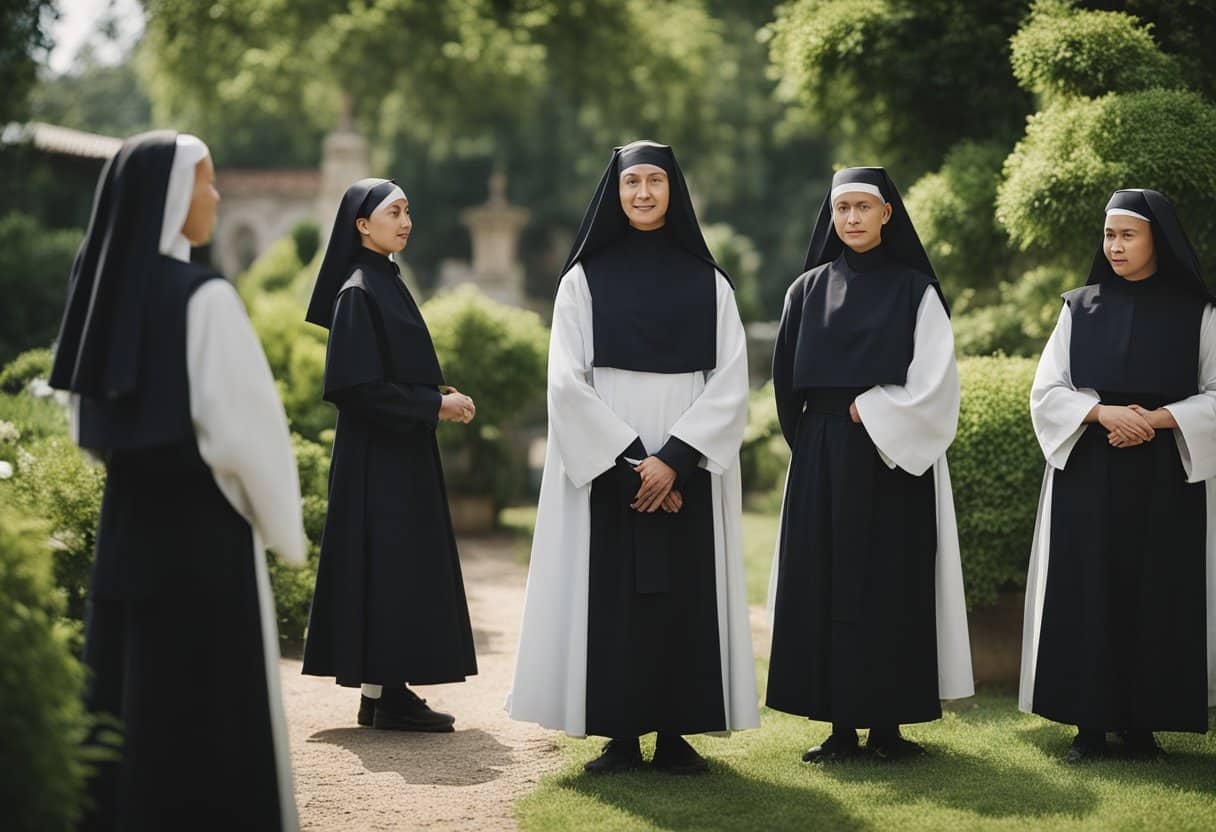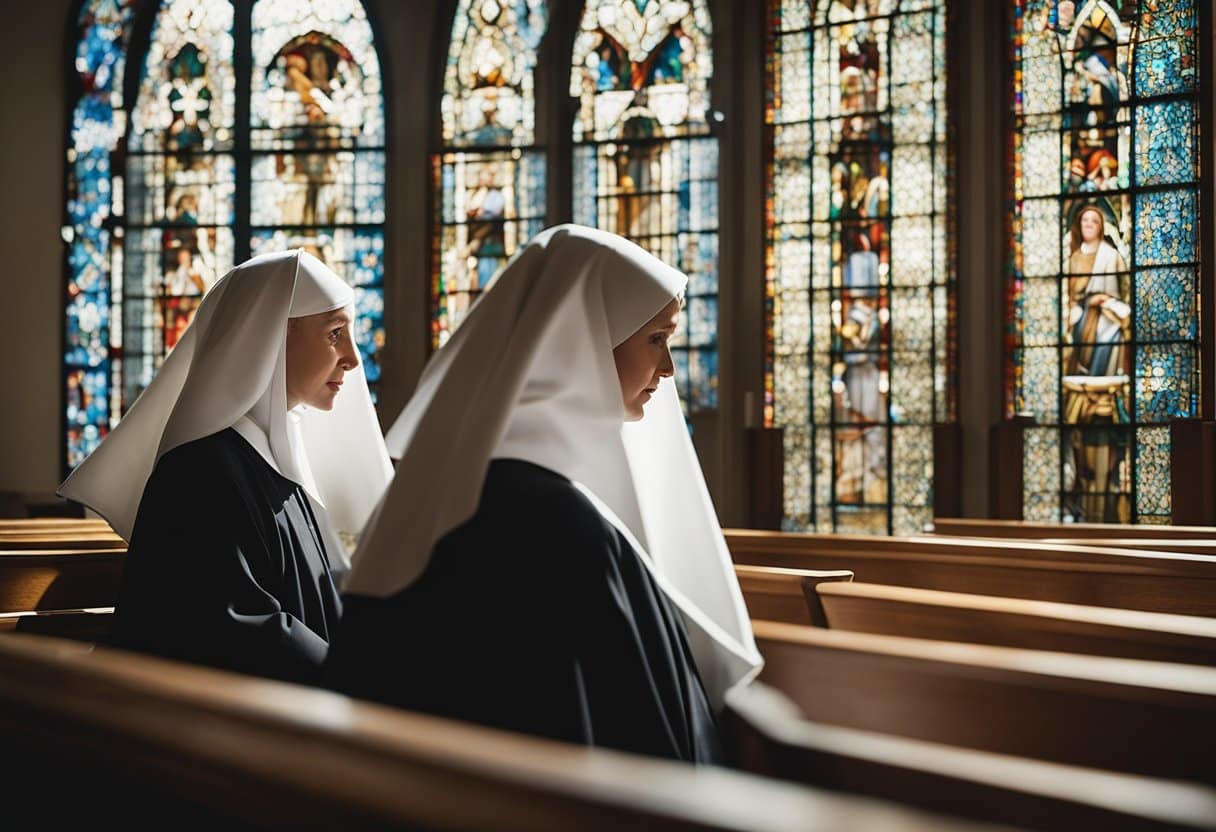As a Christian and a former pastor, I have often been asked the question, “Do nuns have to cut their hair?”
The answer to this question is not a simple yes or no. The rules surrounding hair for nuns can vary depending on the religious order and community they belong to.
However, there are some general guidelines that most nuns follow.

In the Catholic Church, nuns are considered Brides of Christ and their commitment to a sacred lifestyle is symbolized by their physical appearance.
This includes covering their hair as a sign of their consecration.
While some religious orders require nuns to shave their heads or cut their hair very short, most nuns get regular haircuts to keep their hair tidy and maintain their appearance.
Some nuns even cut each other’s hair or have their hair cut by their superiors.
Also Read: Nuns and Tattoos
Historical and Cultural Context of Cutting Hair of Nuns

Throughout history, hair has been a symbol of beauty, strength, and power. In many cultures, long hair was seen as a sign of femininity and was highly valued.
However, in some religious traditions, including Christianity, nuns are required to cut their hair or cover it with a veil or head covering.
The tradition of nuns wearing head coverings dates back to the Middle Ages when monastic communities began to form.
The veil was seen as a symbol of religious devotion and humility and was worn by both men and women.
As the monastic tradition evolved, the veil became more closely associated with women, and nuns began to wear a variety of head coverings, including bonnets, wimples, and headscarves.
In the Catholic Church, nuns are required to wear a veil or head covering as a sign of their commitment to their vows of poverty, chastity, and obedience.
The veil is also seen as a symbol of their spiritual marriage to Christ. In some orders, nuns are required to cut their hair short, while in others, they are allowed to keep their hair long but must cover it with a headpiece or scarf.
The practice of covering one’s head is not unique to Christianity. In many cultures and religions, women are required to cover their heads as a sign of modesty and respect.
In the Eastern Orthodox Church, for example, women are required to wear a headscarf or veil during worship services.
In conclusion, the tradition of nuns cutting their hair or covering it with a veil or head covering has a long and rich history in the monastic tradition.
While the practice may seem outdated or unnecessary to some, it continues to be an important symbol of religious devotion and humility for many nuns around the world.
Understanding the Significance of Hair in Religious Practices
As a symbol of femininity, hair has been a subject of religious significance for centuries. In many traditions, hair is associated with vanity and sexuality and is often seen as a distraction from spiritual devotion.
As a result, many religious practices require women to cover or cut their hair as a sign of humility and devotion to God.
In some religious orders, nuns are required to cut their hair as a symbol of their renouncement of vanity and commitment to a life of simplicity and obedience to God.
While some nuns may shave their heads completely, others receive regular haircuts from their superiors or local hairdressers.
The act of cutting hair is often seen as a form of submission to God and is a way for nuns to express their devotion to their faith.
In addition to cutting their hair, nuns may also wear a habit, which is a traditional black garment that covers their body and head.
The habit is a symbol of the nun’s devotion to God and is often worn during times of prayer and worship. Some religious orders also require nuns to wear a veil, which is a head covering that symbolizes piety and modesty.
While the practice of cutting hair and wearing a habit or veil is most commonly associated with Catholic nuns, similar practices can be found in other religious traditions as well.
For example, Orthodox Jewish women may wear a wig or scarf to cover their hair, while Muslim women may wear a hijab as a sign of their devotion to God.
Overall, the significance of hair in religious practices varies depending on the tradition and the individual’s personal choice.
However, for many religious women, cutting or covering their hair is seen as a way to express their devotion to God and their commitment to a life of humility and obedience.
Why Some Nuns Cut or Shave Their Hair

As a nun, cutting or shaving one’s hair is a common practice. It is often seen as a symbol of the nun’s vow of poverty, humility, and simplicity.
In many religious orders, nuns are required to cut their hair short, while some even shave their heads entirely.
The vow of poverty is a significant aspect of religious life, and nuns cutting their hair is a way to demonstrate their commitment to this vow.
It is an act of renouncement of vanity and a way to show that one’s dignity is not based on physical appearance.
In addition to the vow of poverty, nuns cutting or shaving their hair can also represent the vow of obedience to God.
By submitting to the religious order’s rules and cutting their hair, nuns demonstrate their submission to God’s will.
The practice of cutting or shaving one’s hair is also rooted in the Bible. In 1 Corinthians 11:15, it is written that “if a woman has long hair, it is her glory? For her hair is given to her for a covering.”
Some religious orders interpret this passage as a call to cut or shave one’s hair as a sign of devotion to God.
It is worth noting that not all nuns are required to cut or shave their hair. Some religious orders allow nuns to keep their hair long, while others require nuns to cut their hair only once they have taken their final vows.
Ultimately, the decision to cut or shave one’s hair is up to the individual nun and their religious order’s rules.
In conclusion, cutting or shaving one’s hair is a common practice among nuns, and it is often seen as a symbol of their vow of poverty, humility, and simplicity.
It is an act of renouncement of vanity and a way to demonstrate their submission to God’s will.
While not all nuns are required to cut or shave their hair, it is a significant aspect of religious life for many.
The Role of Veils and Other Head Coverings

As a nun, wearing a veil or other head covering is an essential part of the habit.
The veil covers the hair and head of the nun and is a symbol of her status and affiliation with the church. It is also a sign of her submission to God.
In some religious orders, nuns wear veils that are color-coded depending on their seniority.
Veils and other head coverings are not unique to Catholicism or nuns. Muslim, Sikh, and Hindu women wear head coverings of some type outside of the home, according to the Pew Research Center. The same is true for Muslim and Sikh men.
In addition to veils, nuns may also wear other head coverings such as scarves, headpieces, hijabs, headscarves, headdresses, and coifs.
These head coverings may vary depending on the religious order and cultural traditions.
Overall, the role of veils and other head coverings in the life of a nun is significant. It serves as a symbol of her commitment to God and her religious order.
Comparison with Other Religious Traditions

As we have seen, nuns in the Catholic Church are required to cover their hair as a symbol of their devotion to God and their vows of chastity, poverty, and obedience.
However, this practice is not unique to the Catholic Church.
Many other religious traditions also require women to cover their hair.
In Islam, for example, women are required to wear a hijab or headscarf as a sign of modesty and religious observance.
This practice is based on the Quranic injunction to “draw their veils over their bosoms” (Quran 24:31).
Similarly, Orthodox Jewish women wear headscarves or wigs as a sign of modesty and piety, while men wear yarmulkes as a sign of reverence for God.
In some cultures, both men and women cover their heads as a sign of respect or devotion.
For example, Sikh men wear turbans as a sign of their commitment to their faith, while Muslim men may wear a taqiyah or cap as a sign of their piety.
In some religious traditions, cutting or shaving the hair is also a sign of devotion. Buddhist monks, for example, shave their heads as a sign of their renunciation of worldly desires and their commitment to the path of enlightenment.
In the Catholic Church, some nuns may shave their heads as a sign of their total commitment to God, while others may have their hair cut short as a practical matter.
Overall, the practice of covering the hair or shaving the head as a sign of religious devotion is a common one across many different cultures and traditions.
While the specifics of these practices may vary, the underlying message is the same: a sign of commitment to one’s faith and a symbol of reverence for God.

The cutting of one’s hair is a sign of the renunciation of the ego, a letting go of worldly things and a commitment to God. It is a sign of the letting go of the attachments to mortal life and embracing higher things.